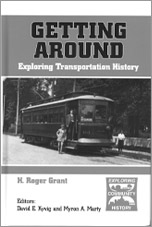Book Review
Getting Around: Exploring Transportation History
By H. Roger Grant. Malabar, FL: Krieger Publishers, 2003; 190 pp., illustrations, appendices, index; cloth $29.50; paper $24.50.
 |
A growing number of people seem to realize that they are products of their past, and they want to connect with that past, individually or as part of a larger community. When historical questions focus on local or regional issues, both amateur and professional historians sometimes flnd themselves at a loss about where to look for information about a fleld new to them. Big national and international topics may be covered by considerable literature and resources such as the National Archives, Library of Congress, and the various state archives are well known, but most of us live in a smaller realm. The history of our communities and their everyday life is unique, yet connected to a wider world. But where does one begin to look for information about local life? What is really important? How can useful data be assembled and analyzed?
With its Exploring Community History series, Krieger Publishing Company has provided informative guides to help historians flnd answers to these and other questions about community history. H. Roger Grant's Getting Around: Exploring Transportation History is the fourth book in this series and, as the title indicates, Grant opens windows into the study of local and regional transportation history. Humans have always been mobile creatures, and the topic is central to understanding how any community forms, grows, sometimes fails, and interacts with other communities. As a long-time scholar of transportation history, Grant's wide knowledge of available resources makes him the ideal author for this book.
This is not a history book, nor is it a book about writing history. Rather, it is a book about sources for researching a very complex industry from several points of view. The depth and breadth of Grant's knowledge of the fleld becomes increasingly evident the more one reads, and he has done a good job of organizing an immense amount of material into a concise, useable form.
The book is organized by transportation modes, and they appear in roughly chronological order. Grant devotes a chapter each to natural waterways, roads, canals, railroads, interurbans, urban transit, and aviation. Written in a readable narrative style, each chapter opens with a brief overview of a particular mode, then narrows to a local focus and concentrates on how individuals interacted with the mode and suggests ways that transportation influenced their lives. He notes the kinds of structures (or their remains) and other artifacts that may still exist, where to look for them, and how to recognize evidence of a past life in the transportation industry, even though a structure may have been in some other, unrelated use for years.
Grant also discusses the types of public and private records that each operation likely generated and offers sage advice on where these might be found. Within each chapter, information is grouped into subheadings, a big help for consulting the book on a speciflc topic. The chapter on railroads is typical, with subheadings for depots, companies, employees, rolling stock, artifacts (lanterns, keys, etc.), accidents (records and images), and additional pointers (maps, timetables, rule books, etc.). The chapter on roads deals not only with everything from trails to interstates, but also discusses sources for bus- and truck-line data and information often available from related industries, such as tire and oil companies.
Grant's approach is quite thorough. He lists major secondary works where they exist, and he notes a number of speciflc museums and archives. Where the resources are not well deflned, Grant provides an overview of what one might look for, such as retired employees' associations, flre insurance maps, property records, and even picture postcards. The illustrations, while often small because of the book's 6-by-9-inch format, give the reader, especially one new to the fleld, a good sense of the relevant artifacts. While Grant cautions that few, if any, records or artifacts may survive from an endeavor that failed, even an experienced professional historian will come away from this little book with a rejuvenated sense of what is out there, remaining to be explored. As an additional encouragement, Grant ends the book with a brief chapter outlining a variety of ways that amateur historians might utilize and disseminate the information that they gather.
This book should enjoy a wide audience. It certainly will not create a competent historian in one easy lesson, but that is not its intent. Grant tries to steer the serious researcher towards good source material about transportation, particularly sources that might be productive yet easy to overlook. Since communities grew around their transportation networks, anyone starting an exploration into community history will flnd it to be a valuable companion.
J. Lawrence Lee
National Park Service
